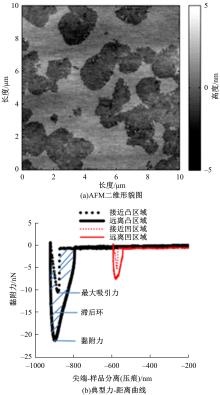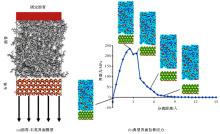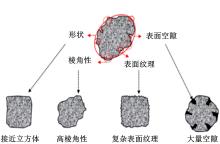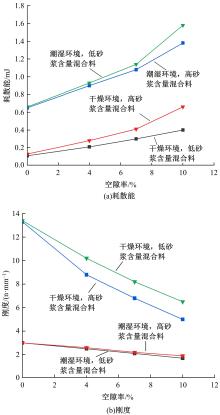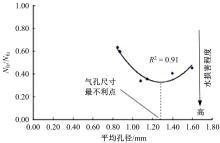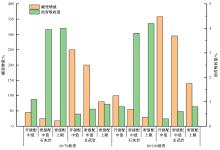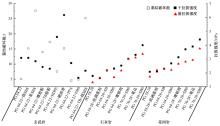Journal of Jilin University(Engineering and Technology Edition) ›› 2023, Vol. 53 ›› Issue (9): 2437-2464.doi: 10.13229/j.cnki.jdxbgxb.20221433
Adhesion and raveling property between asphalt and aggregate: a review
Sheng-qian ZHAO1( ),Zhuo-hong CONG2(
),Zhuo-hong CONG2( ),Qing-long YOU1,Yuan LI1
),Qing-long YOU1,Yuan LI1
- 1.School of Highway,Chang′an University,Xi′an 710064,China
2.Key Laboratory of Road Construction Technology & Equipment of Ministry of Education,Chang′an University,Xi′an 710064,China
CLC Number:
- U416.217
| 1 | Guo F, Pei J, Zhang J, et al. Study on the adhesion property between asphalt binder and aggregate: a state-of-the-art review[J]. Construction and Building Materials, 2020, 256: No. 119474. |
| 2 | Mehrara A, Khodaii A. A review of state of the art on stripping phenomenon in asphalt concrete[J]. Construction and Building Materials, 2013, 38: 423-442. |
| 3 | Canestrari F, Cardone F, Graziani A, et al. Adhesive and cohesive properties of asphalt-aggregate systems subjected to moisture damage[J]. Road Materials and Pavement Design, 2010, 11(): 11-32. |
| 4 | Caro S, Masad E, Bhasin A, et al. Moisture susceptibility of asphalt mixtures, part 1: mechanisms[J]. International Journal of Pavement Engineering, 2008, 9(2): 81-98. |
| 5 | Kakar M R, Hamzah M O, Valentin J. A review on moisture damages of hot and warm mix asphalt and related investigations[J]. Journal of Cleaner Production, 2015, 99: 39-58. |
| 6 | Soenen H, Vansteenkiste S, de Maeijer P K. Fundamental approaches to predict moisture damage in asphalt mixtures: state-of-the-art review[J]. Infrastructures, 2020, 5(2): No.20. |
| 7 | 王岚, 罗学东, 张琪, 等. 温拌胶粉改性沥青-集料粘附性及其体系水稳定性分析[J]. 材料导报, 2022, 36(8): 123-130. |
| Wang Lan, Luo Xue-dong, Zhang Qi, et al. Analysis of adhesion of warm mix rubber powder modified asphalt aggregates and water stability of the system[J]. Materals Reports, 2022, 36(8): 123-130. | |
| 8 | Ghabchi R, Singh D, Zaman M, et al. Micro-structural analysis of moisture-induced damage potential of asphalt mixes containing RAP[J]. Journal of Testing and Evaluation, 2016, 44(1): 194-205. |
| 9 | Kim Y R, Little D, Lytton R. Fatigue and healing characterization of asphalt mixtures[J]. Journal of Materials in Civil Engineering, 2003, 15(1): 75-83. |
| 10 | Kim Y R, Little D N, Lytton R L. Effect of moisture damage on material properties and fatigue resistance of asphalt mixtures[J]. Transportation Research Record, 2004, 1891(1): 48-54. |
| 11 | Yu X, Burnham N A, Tao M. Surface microstructure of bitumen characterized by atomic force microscopy[J]. Advances in Colloid and Interface Science, 2015, 218: 17-33. |
| 12 | Yao H, Liu J, Xu M, et al. Discussion on molecular dynamics (MD) simulations of the asphalt materials[J]. Advances in Colloid and Interface Science, 2022, 299: No.102565. |
| 13 | McBain J W, Hopkins D G. On adhesives and adhesive action[J]. The Journal of Physical Chemistry, 1925, 29(2): 188-204. |
| 14 | Canestrari F, Ferrotti G, Cardone F, et al. Innovative testing protocol for evaluation of binder-reclaimed aggregate bond strength[J]. Transportation Research Record: Journal of the Transportation Research Board, 2014, 2444(1): 63-70. |
| 15 | Petersen J, Plancher H, Ensley E, et al. Chemistry of asphalt-aggregate interaction: relationship with pavement moisture-damage prediction test[J]. Transportation Research Record, 1982, 843: 95-104. |
| 16 | Hefer A W, Little D N, Lytton R L. A synthesis of theories and mechanisms of bitumen-aggregate adhesion including recent advances in quantifying the effects of water[J]. Journal of the Association of Asphalt Paving Technologists, 2005, 74(139): No.e196. |
| 17 | Huang S C, Branthaver J F, Robertson R E. Interaction of asphalt films with aggregate surfaces in the presence of water[J]. Road Materials and Pavement Design, 2002, 3(1): 23-48. |
| 18 | Petersen J C, Plancher H. Model studies and interpretive review of the competitive adsorption and water displacement of petroleum asphalt chemical functionalities on mineral aggregate surfaces[J]. Petroleum Science and Technology, 1998, 16(1/2): 89-131. |
| 19 | Tan Y, Guo M. Using surface free energy method to study the cohesion and adhesion of asphalt mastic[J]. Construction and Building Materials, 2013, 47: 254-260. |
| 20 | 陈燕娟. 酸性集料表面活化技术与粘附机理研究[D]. 西安: 长安大学材料科学与工程学院, 2012. |
| Chen Yan-juan.Surface activation technology of acid aggregate and adhesion mechanism[D]. Xi'an: School of Materials Science and Engineering, Chang'an University, 2012. | |
| 21 | 任玉娜. 聚合物改性沥青粘聚性与粘附性研究[D]. 青岛: 中国石油大学(华东)化学化工学院, 2011. |
| Ren Yu-na. Research on cohesion and adhesion properties of polymer modified asphalt[D]. Qingdao: College of Chemistry and Chemical Engineering, China University of Petroleum, 2011. | |
| 22 | Ensley E K. Multilayer adsorption with molecular orientation of asphalt on mineral aggregate and other substrates[J]. Journal of Applied Chemistry and Biotechnology, 1975, 25(9): 671-682. |
| 23 | 庞骁奕. 基于AFM与表面能原理的沥青与集料粘附特性分析[D]. 哈尔滨: 哈尔滨工业大学交通科学与工程学院, 2015. |
| Pang Xiao-yi. Asphalt and aggregate adhesion characteristics analysis based on the principle of AFM and the surface energy[D]. Harbin: School of Transportation Science and Engineering, Harbin Institute of Technology, 2015. | |
| 24 | Huang S C, Robertson R E. Rheology of thin asphalt films in contact with aggregate[J]. Road Materials and Pavement Design, 2006, 7(2): 179-199. |
| 25 | Bagampadde U, Isacsson U, Kiggundu B M. Classical and contemporary aspects of stripping in bituminous mixes[J]. Road Materials and Pavement Design, 2004, 5(1): 7-43. |
| 26 | Caro S, Masad E, Bhasin A, et al. Moisture susceptibility of asphalt mixtures, part 2: characterisation and modelling[J]. International Journal of Pavement Engineering, 2008, 9(2): 99-114. |
| 27 | 周卫峰. 沥青与集料界面粘附性研究[D]. 西安: 长安大学材料科学与工程学院, 2002. |
| Zhou Wei-feng. Study on adhesion of interface between asphalt and aggregate[D]. Xi'an: School of Materials Science and Engineering, Chang'an University, 2002. | |
| 28 | 陈斌华. 基于光电比色法的沥青与矿料粘附效应研究[D]. 西安: 长安大学公路学院, 2014. |
| Chen Bin-hua. Based on the photoelectric colormetric method of asphalt and mineral aggregate adhesion effect [D]. Xi'an: School of Highway, Chang'an University, 2014. | |
| 29 | 宋艳茹, 张玉贞. 沥青粘附性能评价方法综述[J]. 石油沥青, 2005(3): 1-6. |
| Song Yan-ru, Zhang Yu-zhen. The evaluating methods' summary of asphalt adhesion[J]. Petroleum Asphalt, 2005(3): 1-6. | |
| 30 | Kanitpong K, Bahia H. Relating adhesion and cohesion of asphalts to the effect of moisture on laboratory performance of asphalt mixtures[J]. Transportation Research Record, 2005, 1901(1): 33-43. |
| 31 | Zhang J, Apeagyei A K, Airey G D, et al. Influence of aggregate mineralogical composition on water resistance of aggregate-bitumen adhesion[J]. International Journal of Adhesion and Adhesives, 2015, 62: 45-54. |
| 32 | 徐青杰.沥青-集料黏附性能多尺度分析与评价方法研究[D]. 重庆: 重庆交通大学交通运输学院, 2020. |
| Xu Qing-jie. Multi-scale analysis and evaluation method of asphalt-aggregate adhesion [D]. Chongqing: College of Traffic and Transportation, Chongqing Jiaotong University, 2020. | |
| 33 | 王威娜, 徐青杰, 周圣雄, 等. 沥青-集料黏附作用评价方法综述[J]. 材料导报, 2019, 33(13): 2197-2205. |
| Wang Wei-na, Xu Qing-jie, Zhou Sheng-xiong, et al. A review on evaluation methods of asphalt-aggregate adhesion[J]. Materials Reports, 2019, 33(13): 2197-2205. | |
| 34 | Blackman B R, Cui S, Kinloch A J, et al. The development of a novel test method to assess the durability of asphalt road-pavement materials[J]. International Journal of Adhesion and Adhesives, 2013, 42: 1-10. |
| 35 | Cui S, Blackman B R, Kinloch A J, et al. Durability of asphalt mixtures: effect of aggregate type and adhesion promoters[J]. International Journal of Adhesion and Adhesives, 2014, 54: 100-111. |
| 36 | Mo L T. Damage development in the adhesive zone and mortar of porous asphalt concrete[D]. Netherlands: Faculty of Civil Engineering and Geosciences, Delft University of Technology, 2010. |
| 37 | Kanitpong K, Bahia H U. Role of adhesion and thin film tackiness of asphalt binders in moisture damage of HMA (with discussion)[J]. Journal of the Association of Asphalt Paving Technologists, 2003, 72: 502-528. |
| 38 | Cho D W, Bahia H U. Effects of aggregate surface and water on rheology of asphalt films[J]. Transportation Research Record, 2007, 1998(1): 10-17. |
| 39 | 肖月. 沥青混合料中胶浆-集料粘结性及力学性能研究[D]. 武汉: 武汉理工大学材料科学与工程学院, 2008. |
| Xiao Yue. Fracture mechanisms of binder-aggregate system and its effect on properties of asphalt mixtures [D].Wuhan: School of Materials Science and Engineering, Wuhan University of Technology, 2008. | |
| 40 | Huang B, Shu X, Dong Q, et al. Laboratory evaluation of moisture susceptibility of hot-mix asphalt containing cementitious fillers[J]. Journal of Materials in Civil Engineering, 2010, 22(7): 667-673. |
| 41 | Varveri A, Avgerinopoulos S, Scarpas A. Experimental evaluation of long-and short-term moisture damage characteristics of asphalt mixtures[J]. Road Materials and Pavement Design, 2016, 17(1): 168-186. |
| 42 | Collop A C, Choi Y, Airey G. Effects of pressure and aging in SATS test[J]. Journal of Transportation Engineering, 2007, 133(11): 618-624. |
| 43 | Abed A H, Qasim Z I, Al-Mosawe H, et al. The effect of hybrid anti-stripping agent with polymer on the moisture resistance of hot-mix asphalt mixtures[J]. Cogent Engineering, 2019, 6(1): No.1659125. |
| 44 | Murshed A M, Tandon V, Nazarian S, et al. Identification of moisture-susceptible asphalt concrete mixes using modified environmental conditioning system[J]. Transportation Research Record, 1998, 1630(1): 106-116. |
| 45 | Al-Swailmi S, Terrel R L. Evaluation of water damage of asphalt Concrete mixtures using the environmental conditioning system (Ecs)(with discussion)[J]. Journal of the Association of Asphalt Paving Technologists, 1992, 61: 405-445. |
| 46 | 任敏达, 冯汉卿, 丛林, 等. 沥青混合料饱水过程的强度演化规律及机理分析[J]. 建筑材料学报, 2022, 25(5): 537-544. |
| Ren Min-da, Feng Han-qing, Cong Lin, et al. Strength evolution law and mechanism analysis of asphalt mixtures during water saturation[J]. Journal of Building Materials, 2022, 25(5): 537-544. | |
| 47 | Zhou L, Huang W, Xiao F, et al. Shear adhesion evaluation of various modified asphalt binders by an innovative testing method[J]. Construction and Building Materials, 2018, 183: 253-263. |
| 48 | Kim Y R, Lutif J S, Bhasin A, et al. Evaluation of moisture damage mechanisms and effects of hydrated lime in asphalt mixtures through measurements of mixture component properties and performance testing[J]. Journal of Materials in Civil Engineering, 2008, 20(10): 659-667. |
| 49 | Copeland A R, Youtcheff J, Shenoy A. Moisture sensitivity of modified asphalt binders: factors influencing bond strength[J]. Transportation Research Record, 2007, 1998(1): 18-28. |
| 50 | Wasiuddin N M, Saltibus N E, Mohammad L N. Novel moisture-conditioning method for adhesive failure of hot-and warm-mix asphalt binders[J]. Transportation Research Record, 2011, 2208(1): 108-117. |
| 51 | Moraes R, Velasquez R, Bahia H U. Measuring the effect of moisture on asphalt-aggregate bond with the bitumen bond strength test[J]. Transportation Research Record, 2011, 2209(1): 70-81. |
| 52 | Mogawer W S, Austerman A J, Bahia H U. Evaluating the effect of warm-mix asphalt technologies on moisture characteristics of asphalt binders and mixtures[J]. Transportation Research Record, 2011, 2209(1): 52-60. |
| 53 | Júnior J L L, Babadopulos L F, Soares J B. Moisture-induced damage resistance, stiffness and fatigue life of asphalt mixtures with different aggregate-binder adhesion properties[J]. Construction and Building Materials, 2019, 216: 166-175. |
| 54 | Bagampadde U, Isacsson U, Kiggundu B. Impact of bitumen and aggregate composition on stripping in bituminous mixtures[J]. Materials and Structures, 2006, 39(3): 303-315. |
| 55 | Bagampadde U, Isacsson U, Kiggundu B. Influence of aggregate chemical and mineralogical composition on stripping in bituminous mixtures[J]. The international Journal of Pavement Engineering, 2005, 6(4): 229-239. |
| 56 | 豆莹莹, 李晓民, 姚志杰, 等. 基于表面自由能的再生沥青粘附性及其水稳定性[J]. 材料科学与工程学报, 2020, 38(4): 648-653. |
| Dou Ying-ying, Li Xiao-min, Yao Zhi-jie, et al. Adhesion and water stability of regenerated asphalt based on surface free energy[J]. Journal of Materials Science & Engineering, 2020, 38(4): 648-653. | |
| 57 | 成志强, 张晓燕, 孔繁盛, 等. 利用表面能理论及拉脱试验分析沥青膜的剥离行为[J]. 材料导报,2020,34():1288-1294. |
| Cheng Zhi-qiang, Zhang Xiao-yan, Kong Fan-sheng,et al. Investigation on stripping behavior of asphalt Film using surface energy theory and pull-off test[J]. Materials Reports, 2020, 34(Sup.2): 1288-1294. | |
| 58 | Wasiuddin N M, Zaman M M, ORear E A. Effect of sasobit and aspha-min on wettability and adhesion between asphalt binders and aggregates[J]. Transportation Research Record, 2008, 2051(1): 80-89. |
| 59 | Bhasin A, Little D N, Vasconcelos K L, et al. Surface free energy to identify moisture sensitivity of materials for asphalt mixes[J]. Transportation Research Record, 2007, 2001(1): 37-45. |
| 60 | Wang W, Shen A, Yang X, et al. Surface free energy method for evaluating the effects of anti-stripping agents on the moisture damage to asphalt mixtures[J]. Journal of Adhesion Science and Technology, 2020, 34(18): 1947-1970. |
| 61 | Hamedi G H, Moghadas Nejad F. Using energy parameters based on the surface free energy concept to evaluate the moisture susceptibility of hot mix asphalt[J]. Road Materials and Pavement Design, 2015, 16(2): 239-255. |
| 62 | Al-Rawashdeh A S, Sargand S. Performance assessment of a warm asphalt binder in the presence of water by using surface free energy concepts and nanoscale techniques[J]. Journal of Materials in Civil Engineering, 2014, 26(5): 803-811. |
| 63 | 王端宜, 郭秀林, 唐成. 基于真实沥青膜厚的沥青与集料黏结性能评价与验证[J]. 建筑材料学报, 2021, 24(3): 624-629. |
| Wang Duan-lin, Guo Xiu-lin, Tang Cheng. Bonding performance evaluation and verification between asphalt and aggregate based on true asphalt film thickness[J]. Journal of Building Materials, 2021, 24(3): 624-629. | |
| 64 | Yi J, Pang X, Feng D, et al. Studies on surface energy of asphalt and aggregate at different scales and bonding property of asphalt-aggregate system[J]. Road Materials and Pavement Design, 2018, 19(5): 1102-1125. |
| 65 | Moraes R, Velasquez R, Bahia H. Using bond strength and surface energy to estimate moisture resistance of asphalt-aggregate systems[J]. Construction and Building Materials, 2017, 130: 156-170. |
| 66 | Guo M, Tan Y, Zhou S. Multiscale test research on interfacial adhesion property of cold mix asphalt[J]. Construction and Building Materials, 2014, 68: 769-776. |
| 67 | Kim S H, Jeong J H, Kim N. Use of surface free energy properties to predict moisture damage potential of asphalt concrete mixture in cyclic loading condition[J]. KSCE Journal of Civil Engineering, 2003, 7(4): 381-387. |
| 68 | Arabani M, Hamedi G H. Using the surface free energy method to evaluate the effects of polymeric aggregate treatment on moisture damage in hot-mix asphalt[J]. Journal of Materials in Civil Engineering, 2011, 23(6): 802-811. |
| 69 | Hamedi G H. Effects of polymeric coating the aggregate surface on reducing moisture sensitivity of asphalt mixtures[J]. International Journal of Civil Engineering, 2018, 16(9): 1097-1107. |
| 70 | 马翔, 胡绪泉, 王丽丽, 等. 基于表面自由能研究水温耦合作用对沥青黏结性能的影响[J]. 森林工程, 2022, 38(4): 140-146. |
| Ma Xiang, Hu Xu-quan, Wang Li-li. Study on the effect of water temperature coupling on asphalt bond performance based on surface free energy[J]. Forest Engineering, 2022, 38(4): 140-146. | |
| 71 | 冯浩浩, 苗强, 李振纲, 等. 基于表面能理论的再生集料与沥青黏附性影响研究[J/OL]. [2022-11-05]. |
| 72 | Hamedi G H, Moghadas N F. Evaluating the effect of mix design and thermodynamic parameters on moisture sensitivity of hot mix asphalt[J]. Journal of Materials in Civil Engineering, 2017, 29(2): No.04016207. |
| 73 | Masad E A, Zollinger C, Bulut R, et al. Characterization of HMA moisture damage using surface energy and fracture properties (With Discussion)[J]. Journal of the Association of Asphalt Paving Technologists, 2006, 75: 713-754. |
| 74 | Loeber L, Sutton O, Morel J, et al. New direct observations of asphalts and asphalt binders by scanning electron microscopy and atomic force microscopy[J]. Journal of Microscopy, 1996, 182(1): 32-39. |
| 75 | Das P K, Baaj H, Tighe S, et al. Atomic force microscopy to investigate asphalt binders: a state-of-the-art review[J]. Road Materials and Pavement Design, 2016, 17(3): 693-718. |
| 76 | Tarefder R, Arifuzzaman M. A study of moisture damage in plastomeric polymer modified asphalt binder using functionalized AFM tips[J]. Journal of Systemics, Cybernetics and Informatics, 2011, 9(5): 1-12. |
| 77 | Yao Z, Zhu H, Gong M, et al. Characterization of asphalt materials' moisture susceptibility using multiple methods[J]. Construction and Building Materials, 2017, 155: 286-295. |
| 78 | 易军艳, 庞骁奕, 姚冬冬, 等. 基于原子力显微镜技术的沥青与矿料表面粗糙度及黏附特性[J]. 复合材料学报, 2017, 34(5): 1111-1121. |
| Yi Jun-yan, Pang Xiao-yi, Yao Dong-dong, et al. Characterization of surface roughness and adhesive mechanism of asphalt and mineral aggregate based on atomic force microscopy method[J]. Acta Materiae Compositae Sinica, 2017, 34(5): 1111-1121. | |
| 79 | Xu M, Yi J, Feng D, et al. Analysis of adhesive characteristics of asphalt based on atomic force microscopy and molecular dynamics simulation[J]. ACS Applied Materials & Interfaces, 2016, 8(19): 12393-12403. |
| 80 | Vasconcelos K L, Bhasin A, Little D N. History dependence of water diffusion in asphalt binders[J]. International Journal of Pavement Engineering, 2011, 12(5): 497-506. |
| 81 | dos Santos S, Partl M N, Poulikakos L D. Newly observed effects of water on the microstructures of bitumen surface[J]. Construction and Building Materials, 2014, 71: 618-627. |
| 82 | Lyne Å L, Wallqvist V, Birgisson B. Adhesive surface characteristics of bitumen binders investigated by atomic force microscopy[J]. Fuel, 2013, 113: 248-256. |
| 83 | Yu X, Burnham N A, Mallick R B, et al. A systematic AFM-based method to measure adhesion differences between micron-sized domains in asphalt binders[J]. Fuel, 2013, 113: 443-447. |
| 84 | 邓越, 孙国强, 余可心, 等. 沥青混合料水损坏微纳观尺度研究方法(1)——AFM的应用[J]. 石油沥青, 2018, 32(1): 31-37. |
| Deng Yue, Sun Guo-qiang, Yu Ke-xin, et al. Micro-Nano scale research methods for moisture damage of asphalt mixtures (1)—the application of AFM[J]. Petroleum Asphalt, 2018, 32(1): 31-37. | |
| 85 | 刘克非, 邓林飞, 郑佳宇, 等. 不同沥青结合料水损害的纳米尺度研究[J]. 材料研究学报, 2016, 30(10): 773-780. |
| Liu Ke-fei, Deng Lin-fei, Zheng Jia-yu, et al. Moisture induced damage of various asphalt binders[J]. Chinese Journal of Materials Research, 2016, 30(10): 773-780. | |
| 86 | Tarefder R A, Zaman A M. Nanoscale evaluation of moisture damage in polymer modified asphalts[J]. Journal of Materials in Civil Engineering, 2010, 22(7): 714-725. |
| 87 | Medendorp C A. Atomic force microscopy method development for surface energy analysis[D]. Kentucky:College of Pharmacy, University of Kentucky, 2011. |
| 88 | Chen Z, Pei J, Li R, et al. Performance characteristics of asphalt materials based on molecular dynamics simulation—a review[J]. Construction and Building Materials, 2018, 189: 695-710. |
| 89 | Pauli A T, Miknis F, Beemer A, et al. Assessment of physical property prediction based on asphalt average molecular structures[C]∥Chemistry of Petroleum and Emerging Technologies, Washington, DC,USA, 2005, 50(2): 255-259. |
| 90 | Zhang L, Greenfield M L. Analyzing properties of model asphalts using molecular simulation[J]. Energy & Fuels, 2007, 21(3): 1712-1716. |
| 91 | Zhang L, Greenfield M L. Effects of polymer modification on properties and microstructure of model asphalt systems[J]. Energy & Fuels, 2008, 22(5): 3363-3375. |
| 92 | Hansen J S, Lemarchand C A, Nielsen E, et al. Four-component united-atom model of bitumen[J]. The Journal of Chemical Physics, 2013, 138(9): No.094508. |
| 93 | Li D D, Greenfield M L. Chemical compositions of improved model asphalt systems for molecular simulations[J]. Fuel, 2014, 115: 347-356. |
| 94 | Xu M, Yi J, Qi P, et al. Improved chemical system for molecular simulations of asphalt[J]. Energy & Fuels, 2019, 33(4): 3187-3198. |
| 95 | 马建民, 孙国强, 胡明君, 等. 沥青混合料水损坏微纳观尺度研究方法(3)—分子动力学模拟[J]. 石油沥青, 2018, 32(3): 42-47, 59. |
| Ma Jian-min, Sun Guo-qiang, Hu Ming-jun, et al.Micro-Nano scale research methods for the moisture damage of asphalt mixtures(3)—molecular dynamics simulation[J]. Petroleum Asphalt, 2018, 32(3): 42-47, 59. | |
| 96 | Sun W, Wang H. Moisture effect on nanostructure and adhesion energy of asphalt on aggregate surface: a molecular dynamics study[J]. Applied Surface Science, 2020, 510: No.145435. |
| 97 | Xu G, Wang H. Molecular dynamics study of interfacial mechanical behavior between asphalt binder and mineral aggregate[J]. Construction and Building Materials, 2016, 121: 246-254. |
| 98 | Wang H, Lin E, Xu G. Molecular dynamics simulation of asphalt-aggregate interface adhesion strength with moisture effect[J]. International Journal of Pavement Engineering, 2017, 18(5): 414-423. |
| 99 | Yao H, Dai Q, You Z. Chemo-physical analysis and molecular dynamics (MD) simulation of moisture susceptibility of nano hydrated lime modified asphalt mixtures[J]. Construction and Building Materials, 2015, 101: 536-547. |
| 100 | Zheng C, Shan C, Liu J, et al. Microscopic adhesion properties of asphalt-mineral aggregate interface in cold area based on molecular simulation technology[J]. Construction and Building Materials, 2021, 268: No.121151. |
| 101 | Luo L, Chu L, Fwa T. Molecular dynamics analysis of moisture effect on asphalt-aggregate adhesion considering anisotropic mineral surfaces[J]. Applied Surface Science, 2020, 527: No.146830. |
| 102 | Lu Y, Wang L. Nanoscale modelling of mechanical properties of asphalt-aggregate interface under tensile loading[J]. International Journal of Pavement Engineering, 2010, 11(5): 393-401. |
| 103 | Lu Y, Wang L. Atomistic modelling of moisture sensitivity: a damage mechanisms study of asphalt concrete interfaces[J]. Road Materials and Pavement Design, 2017, 18(Sup.3): 200-214. |
| 104 | Swamy A K, Matolia V, Ramana G. Interrelationship between uncompacted void content of aggregates and asphalt concrete properties[J]. Particulate Science and Technology, 2019, 37(5): 623-631. |
| 105 | 王志祥, 李建阁, 张争奇. 集料形态特征对集料-沥青黏附及水稳定性的影响[J]. 建筑材料学报, 2021, 24(5): 1039-1047. |
| Wang Zhi-xiang, Li Jian-ge, Zhang Zheng-qi. Effects of aggregate morphological characteristics on adhesion of aggregate‑asphalt and its moisture stability[J]. Journal of Building Materials, 2021, 24(5): 1039-1047. | |
| 106 | 王璐. 沥青-集料界面相结构和粘附机理研究[D]. 西安: 长安大学公路学院, 2014. |
| Wang Lu. Investigation of the interface structure and adhesion mechanism between asphalt and aggregate[D]. Xi'an: School of Highway, Chang'an University, 2014. | |
| 107 | 苏文超. 碎石颗粒形状对沥青混合料性能影响的试验研究[D]. 长沙: 长沙理工大学交通运输工程学院, 2013. |
| Su Wen-chao. Experimental study on gravel particle shape effect on the performance of asphalt mixture[D]. Changsha: School of Traffic & Transportation Engineering, Changsha University, 2013. | |
| 108 | Airey G, Collop A, Zoorob S, et al. The influence of aggregate, filler and bitumen on asphalt mixture moisture damage[J]. Construction and Building Materials, 2008, 22(9): 2015-2024. |
| 109 | Cala A, Caro S, Lleras M, et al. Impact of the chemical composition of aggregates on the adhesion quality and durability of asphalt-aggregate systems[J]. Construction and Building Materials, 2019, 216: 661-672. |
| 110 | 虞将苗, 周文理. 宏纳观多尺度集料-沥青粘附性评价[J]. 材料导报, 2021, 35(2): 2052-2056. |
| Yu Jiang-miao, Zhou Wen-li. Experimental study on gravel particle shape effect on the performance of asphalt mixture[J]. Materials Reports, 2021, 35(2): 2052-2056. | |
| 111 | Blazek J, Sebor G, Maxa D. Effect of aggregate composition on asphalt-aggregate adhesion[J]. Petroleum and Coal, 2000, 42(1): 46-51. |
| 112 | Huang M, Zhang H, Gao Y, et al. Study of diffusion characteristics of asphalt-aggregate interface with molecular dynamics simulation[J]. International Journal of Pavement Engineering, 2021, 22(3): 319-330. |
| 113 | Wang H, Wang J, Chen J. Micromechanical analysis of asphalt mixture fracture with adhesive and cohesive failure[J]. Engineering Fracture Mechanics, 2014, 132: 104-119. |
| 114 | Hossain M I, Tarefder R A. Identifying damage in asphalt matrix materials surrounding an aggregate particle[J]. Construction and Building Materials, 2013, 49: 536-546. |
| 115 | Abo Q S, Al S H. Effect of aggregate properties on asphalt mixtures stripping and creep behavior[J]. Construction and Building Materials, 2007, 21(9): 1886-1898. |
| 116 | 豆莹莹, 魏定邦, 李晓民, 等. 沥青-集料界面黏附性衰减机理研究[J]. 建筑材料学报, 2019, 22(5): 771-779. |
| Dou Ying-ying, Wei Ding-bang, Li Xiao-min,et al. Adhesion attenuation mechanism of asphalt-aggregate interface[J]. Journal of Building Materials, 2019, 22(5): 771-779. | |
| 117 | Kutay M E, Aydilek A H. Pore pressure and viscous shear stress distribution due to water flow within asphalt pore structure[J]. Computer Aided Civil and Infrastructure Engineering, 2009, 24(3): 212-224. |
| 118 | Noguera J A H, Quintana H A R, Gómez W D F. The influence of water on the oxidation of asphalt cements[J]. Construction and Building Materials, 2014, 71: 451-455. |
| 119 | 张吉哲, 王静, 李岩, 等. 沥青胶浆-集料界面水盐侵蚀损伤规律研究[J]. 材料导报, 2022, 36(16): 21-29. |
| Zhang Ji-zhe, Wang Jing, Li Yan. Study on water and salt erosion damage of asphalt mortar-aggregate interface[J]. Materials Reports, 2022, 36(16): 21-29. | |
| 120 | 成志强, 张晓燕, 孔繁盛. 水分在沥青膜中的扩散特征[J]. 建筑材料学报, 2021, 24(2): 399-404. |
| Cheng Zhi-qiang, Zhang Xiao-yan, Kong Fan-sheng. Moisture diffusion property into asphalt film[J]. Journal of Building Materials, 2021, 24(2): 399-404. | |
| 121 | Caro S, Masad E, Bhasin A, et al. Probabilistic modeling of the effect of air voids on the mechanical performance of asphalt mixtures subjected to moisture diffusion[J]. Asphalt Paving Technology, 2010, 79: 221-228. |
| 122 | Masad E, Castelblanco A, Birgisson B. Effects of air void size distribution, pore pressure, and bond energy on moisture damage[J]. Journal of Testing and Evaluation, 2006, 34(1): 15-23. |
| 123 | Arambula E, Masad E, Martin A E. Influence of air void distribution on the moisture susceptibility of asphalt mixes[J]. Journal of Materials in Civil Engineering, 2007, 19(8): 655-664. |
| 124 | Schram S, Abdelrahman M. Effects of asphalt film thickness on field performance[J]. Journal of Traffic and Transportation Engineering (English Edition), 2020, 5(7): 600-628. |
| 125 | Kiggundu B M, Roberts F L. Stripping in HMA mixtures: state-of-the-art and critical review of test methods[EB/OL]. [2022-11-04]. |
| 126 | Gao J, Guo C, Liu Y. Measurement of pore water pressure in asphalt pavement and its effects on permeability[J]. Measurement, 2015, 62: 81-87. |
| 127 | Li S, Zhang H, Sun L. Development and simulation measurement of dynamic hydraulic pressure[J]. Journal of Tongji University, 2007, 35(7): No.915. |
| 128 | Lei Y, Hu X, Wang H, et al. Effects of vehicle speeds on the hydrodynamic pressure of pavement surface: measurement with a designed device[J]. Measurement, 2017, 98: 1-9. |
| 129 | 王英, 杨熙, 姜继斌, 等. 动水冲刷作用下季冻区沥青混合料水损害发展的细观过程[J]. 材料导报, 2022, 36(10): 50-56. |
| Wang Ying, Yang Xi, Jiang Ji-bin.The micro process of water damage in asphalt mixture in seasonal frozen area under the dynamic water erosion[J]. Materials Reports, 2022, 36(10): 50-56. | |
| 130 | Feng D, Yi J, Wang D, et al. Impact of salt and freeze-thaw cycles on performance of asphalt mixtures in coastal frozen region of China[J]. Cold Regions Science and Technology, 2010, 62(1): 34-41. |
| 131 | Kutay M E, Aydilek A H. Dynamic effects on moisture transport in asphalt concrete[J]. Journal of Transportation Engineering, 2007, 133(7): 406-414. |
| 132 | Kringos N, Scarpas T, Kasbergen C, et al. Modelling of combined physical-mechanical moisture-induced damage in asphaltic mixes, part 1: governing processes and formulations[J]. International Journal of Pavement Engineering, 2008, 9(2): 115-128. |
| 133 | 周璐, 黄卫东, 吕泉, 等. 不同改性剂对沥青黏结及抗水损害性能的影响[J]. 建筑材料学报, 2021, 24(2): 377-384. |
| Zhou Lu, Huang Wei-dong, Lv Quan,et al. Effects of various modifiers on the bond property and moisture damage resistance of asphalt[J]. Journal of Building Materials, 2021, 24(2): 377-384. | |
| 134 | 季节, 马榕达, 郑文华, 等. TLA和DCLR对沥青与集料黏附性的影响[J]. 重庆交通大学学报: 自然科学版, 2018, 37(1): 54-61. |
| Ji Jie, Ma Rong-da, Zheng Wen-hua, et al. Effect of DCLR and TLA on adhesion characteristics of asphalt and aggregate[J]. Journal of Chongqing Jiaotong University(Natural Science), 2018, 37(1): 54-61. | |
| 135 | Chakravarty H, Sinha S. Moisture damage of bituminous pavements and application of nanotechnology in its prevention[J]. Journal of Materials in Civil Engineering, 2020, 32(8): No.03120003. |
| 136 | Oliviero R C, Teltayev B, Angelico R. Adhesion promoters in bituminous road materials: a review[J]. Applied Sciences, 2017, 7(5): No.524. |
| [1] | Liu YANG,Chuang-ye WANG,Meng-yan WANG,Yang CHENG. Traffic flow characteristics of six⁃lane freeways with a dedicated lane for automatic cars [J]. Journal of Jilin University(Engineering and Technology Edition), 2023, 53(7): 2043-2052. |
| [2] | Zheng-feng ZHOU,Xiao-tao YU,Ya-le TAO,Mao ZHENG,Chuan-qi YAN. High-temperature performance evaluation of resin and elastomer high viscosity asphalt based on grey correlation analysis [J]. Journal of Jilin University(Engineering and Technology Edition), 2023, 53(7): 2078-2088. |
| [3] | Tao MA,Yuan MA,Xiao-ming HUANG. Optimal combination of key parameters of intelligent compaction based on multiple nonlinear regression [J]. Journal of Jilin University(Engineering and Technology Edition), 2023, 53(7): 2067-2077. |
| [4] | Ning WANG,Tao MA,Feng CHEN,Yong-qiang FU. Key factors affecting smart aggregate perception and data analysis methods [J]. Journal of Jilin University(Engineering and Technology Edition), 2023, 53(6): 1799-1808. |
| [5] | Zhe ZHANG,Wei FU,Jun-hui ZHANG,Chao HUANG. Long⁃term characterising plastic behavior of thawed subgrade clay under cyclic loads [J]. Journal of Jilin University(Engineering and Technology Edition), 2023, 53(6): 1790-1798. |
| [6] | Qing-xia ZHANG,Ji-lin HOU,Xin-hao AN,Xiao-yang HU,Zhong-dong DUAN. Road roughness identification method based on vehicle impulse response [J]. Journal of Jilin University(Engineering and Technology Edition), 2023, 53(6): 1765-1772. |
| [7] | Ping JIANG,Ye-wen CHEN,Xian-hua CHEN,Wei-qing ZHANG,Na LI,Wei WANG. Unconfined compression behavior of modified lime stabilized soil under dry wet and freeze⁃thaw cycles [J]. Journal of Jilin University(Engineering and Technology Edition), 2023, 53(6): 1809-1818. |
| [8] | Chun-di SI,Ya-ning CUI,Zhong-yin XU,Tao-tao FAN. Meso⁃mechanical behavior analysis of asphalt bridge deck pavement after interlayer bonding failure [J]. Journal of Jilin University(Engineering and Technology Edition), 2023, 53(6): 1719-1728. |
| [9] | Yan LI,Jiu-peng ZHANG,Zi-xuan CHEN,Guo-jing HUANG,Pei WANG. Evaluation of asphalt pavement performance based on PCA⁃PSO⁃SVM [J]. Journal of Jilin University(Engineering and Technology Edition), 2023, 53(6): 1729-1735. |
| [10] | Xiao-kang ZHAO,Zhe HU,Jiu-peng ZHANG,Jian-zhong PEI,Ning SHI. Research progress in intelligent monitoring of pavement icing based on optical fiber sensing technology [J]. Journal of Jilin University(Engineering and Technology Edition), 2023, 53(6): 1566-1579. |
| [11] | Bing HUI,Xin-yi YANG,Le-yang ZHANG,Yang LI. Influence of detecting track offset on calculation error of asphalt pavement wearing [J]. Journal of Jilin University(Engineering and Technology Edition), 2023, 53(6): 1756-1764. |
| [12] | Jue LI,An-shun ZHANG,Jun-hui ZHANG,Jun-feng QIAN. Model testing and numerical analysis of dynamic response of graded crushed rock base structure [J]. Journal of Jilin University(Engineering and Technology Edition), 2023, 53(6): 1782-1789. |
| [13] | Bo LI,Xin LI,Hong RUI,Yuan LIANG. Displacement prediction of tunnel entrance slope based on variational modal decomposition and grey wolf optimized extreme learning machine [J]. Journal of Jilin University(Engineering and Technology Edition), 2023, 53(6): 1853-1860. |
| [14] | Zhuang-zhuang LIU,Wen-qing ZHENG,Jian ZHENG,Yi-zheng LI,Peng-yu JI,Ai-min SHA. Pavement surface temperature monitoring method based on gridding approach [J]. Journal of Jilin University(Engineering and Technology Edition), 2023, 53(6): 1746-1755. |
| [15] | Chao XIE,Qi-cai WANG,Ben-tian YU,Sheng LI,Xiao-xu LIN,Zhi-ming LU. Determination of elastic modulus by atomic force microscopy and microstructure analysis for polyurethane coating film [J]. Journal of Jilin University(Engineering and Technology Edition), 2023, 53(5): 1322-1330. |
|


